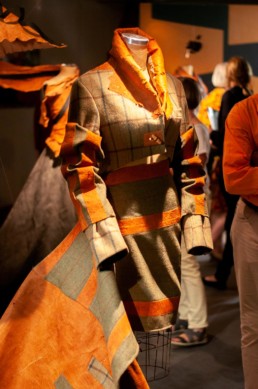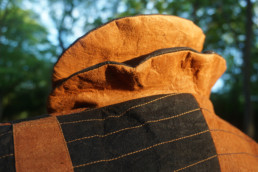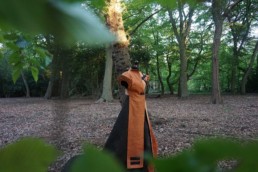José Hendo is a London-based eco-sustainable designer of Ugandan heritage. She creates unique, often avant-garde, garments and accessories for both women and men. She takes a fresh approach to fashion design, challenging the modern, fast fashion throw-away culture. Known for her material choices and clever pattern cutting techniques, her collections are inspired by a mixture of her Ugandan heritage and British influences. She made a conscious decision to work extensively with the centuries-old material barkcloth, it features in all her collections, used innovatively alongside fabrics like organic silk, other eco-textiles and recycled materials. She has won multiple awards for her work.
Signs Of The Now, José’s latest collection is currently on show at the Kunstgewerbemuseum – Berlin’s Museum of Decorative Arts as part of Connecting Afro Futures. Fashion x Hair x Design. The exhibition, which runs until the 1st December 2019 was curated by Fashion Africa Now’s Beatrace Angut Oola, Cornelia Lund from fluctuating images and Claudia Banz of the Kunstgewerbmuseum.
We got in touch with José to be able to share some insights into her work with you, we hope you enjoy reading…


Before we delve deeper, let’s cover the basics first. What is barkcloth? How is it made? What’s it’s history?
Barkcloth is made from the inner bark of the Mutuba tree, or to give its scientific name, Ficus Natalensis. The local name in Uganda for it is olubugo. The craft of barkcloth making is estimated to date back some 700 years. Lule Ssonko, an avid hunter, inadvertently discovered the craft when he was looking for materials to make traps for his hunting. News of his discovery reached the Kabaka, the king of Buganda, who then summoned Ssonko and encouraged him to continue experimenting with material and make clothing for his subjects. Later on, Barkcloth was traded with neighbouring Kingdoms. In 2005, UNESCO named Ugandan barkcloth a masterpiece of oral and intangible heritage of humanity. This sparked a new conversation about its place in both contemporary Ugandan culture and the global research, design and manufacturing market.

You mentioned that it’s been a long journey to where you are now, exhibiting your barkcloth creations in Berlin’s Museum of Decorative Arts. How did the industry respond when you started to work with barkcloth? What have been some of the highlights along the way?
Yes, the journey has taken 19 years so far – my brand was launched 2010/2011. The industry did not know what it was! Some thought it was leather, suede or some type of velvet. This is a difficult question, but the responces I heard were positive about the idea of a renewable source of raw material that does not cost the earth. I choose to use barkcloth as it is, for me, the best ambassador for sustainability – when the bark is removed, the tree regenerates another layer of bark and it can be harvested every year for up to 60 years. As an artist, it has allowed to express myself and convey my sustainable message through many various forms and shapes.
One of the highlights of my career, not long after launching the label, was to be invited to exhibit my work abroad for the first time at the Africa Fashion Day Berlin (Fashion Africa Now’s predecessor). It was a huge success, very well received, and brought good attention to my barkcloth work. In fact one of the highlights of the evening was the famous German diva, Onita, wearing one of my barkcloth designs to open the evening singing “I’m every woman”.
Going to the place in Masaka, Uganda where barkcloth is made for the first time was a truly great moment for me. Having my work in barkcloth acquired by museums is so humbling, I am grateful for the opportunity to share my work with the world. Receiving awards (5 to date including the Radical Designer Award at the FDC Young Designer Awards) has been another high point along the journey!

You were in Berlin to install your work for Connecting Afro Futures. Fashion x Hair x Design and got to speak to many people during the opening weekend. Is there a conversation or interaction you had that has stuck with you?
The moment when a child of 12 years asked to speak with me about my work saying she liked it and got the message, she was looking at the headpiece inspired by the excess use of plastic bottles. She said she would like to be a designer. Then the moment a reporter said she found my installation overwhelming, at this point she had a good look around the whole installation and had finally settled on the centre piece, which depicts the fragmentation of the world when it comes to climate change and the environment. Generally, after months of preparation, to get such a positive response, not just for me but for all of us exhibitors was great. I am grateful to the Kunstgewerbemuseum and the curators for such an amazing opportunity.


Reduce Reuse Recycle, both as a phrase and a concept is a central and recurring theme in your work. Can you talk a bit about how that came to be so important for you and how it influences your practice and your output?
This all happened when I did some research into what happens after the end of a garment’s “first life”. The statistics were shocking, landfill space was running out quickly, not much was repurposed or recycled. I knew then I could not stay in the fashion industry unless I choose to create positive change. So decided to go against the throwaway culture and obsolescent fashion. That was the beginning of my ‘Sustainable By Design’ ethos in which the cornerstones are reduce, reuse and recycle. So, from conceptual thought all the way through to the end product, everything has to be underpinned by the R^3 so I say “The history of a garment is just as important as it’s future” The R^3 became more visible and had a sense of urgency after the Rana Plaza factory collapse in Bangladesh in 2013. I knew then, as all my research had pointed out, that the fashion industry system was broken and things had to change. So in 2014 during London Fashion Week, I started the R^3 campaign using barkcloth and workshops. The same year I started the Bark To The Roots (B2TR) initiative. This initiative is anchored in the Sustainable Development Goals, reminding us to preserve both our heritage and the environment. I intentionally do not mass produce, avoiding overproduction is part of my sustainable approach.

You are based in the UK and work with suppliers in Uganda. How does the discourse around sustainable fashion differ in the two countries and where is there overlap?
The barkcloth I use is from Uganda but I make sure each and every single piece is used to the maximum. Zero-waste. This creates employment for both men and women in Uganda. Uganda like most African countries has become a dumping ground for second-hand clothing destroying the local clothing industry. The majority of Ugandans live a sustainable lifestyle out of necessity, but they do not have this name for it. Things are starting to change though. I address this in my installation – with the inclusion of two upcycled pieces – one with denim jeans and another that transforms a menswear blazer and coat. This shows how the second-hand clothing could be turned into an income-generating business model on a large scale for export.
Who do you design for? Do you have a particular “target customer” in mind?
I design for women predominantly but I do men too in some collections. I do not design for anyone specific, that would hem my design mind in.
What inspires you to keep on going?
The fight against fast fashion by constantly trying to find the best sustainable approach using the R^3 and barkcloth. The endless innovations I am working on with barkcloth. The positive feedback and recognition.

What’s next for you? Are there any major points you still want to tick off your career bucket list?
I have my Bark To The Roots (B2TR) initiative event on the 31 Oct & 1st Nov 2019 at the Serena Hotel in Kampala, Uganda. I will showcase the rest of the Signs Of The Now collection, there will be a live display of barkcloth production, panel discussions about the importance of barkcloth and the mutuba tree in relation to climate change – with a focus on the importance of planting the right trees.
As for my career bucket list, I still have so much to do the R^3 campaign and barkcloth innovation, especially now that we have started hand-weaving barkcloth with organic cotton (also sourced in Uganda). This process has taken 17 years to get right, working with women weavers and empowering them. So having the 1st garment ever made out of handwoven Ugandan barkcloth on display at the Kunstgewerbmuseum is amazing, but there is still work to be done.

Check out José’s installation “Signs of the Now” in the exhibition Connecting Afro Futures. Fashion x Hair x Design at the Kunstgewerbemuseum until the 1st of December.
Keep up with her work on her website – josehendo.com – or on Facebook and Instagram
Text: Beatrace Angut Oola & Helen Gimber
Connecting Afro Futures.
Fashion × Hair × Design
Funded by the TURN Fund of the German Federal Cultural Foundation / Gefördert im Fonds TURN der Kulturstiftung des Bundes
Project Partners / Projektpartner
Kunstgewerbemuseum / Museum of Decorative Arts, Berlin; fluctuating images, Berlin; Fashion Africa Now, Hamburg; Goethe-Zentrum Kampala; Ugandan Arts Trust, Kampala; Wakh’Art, Dakar.

